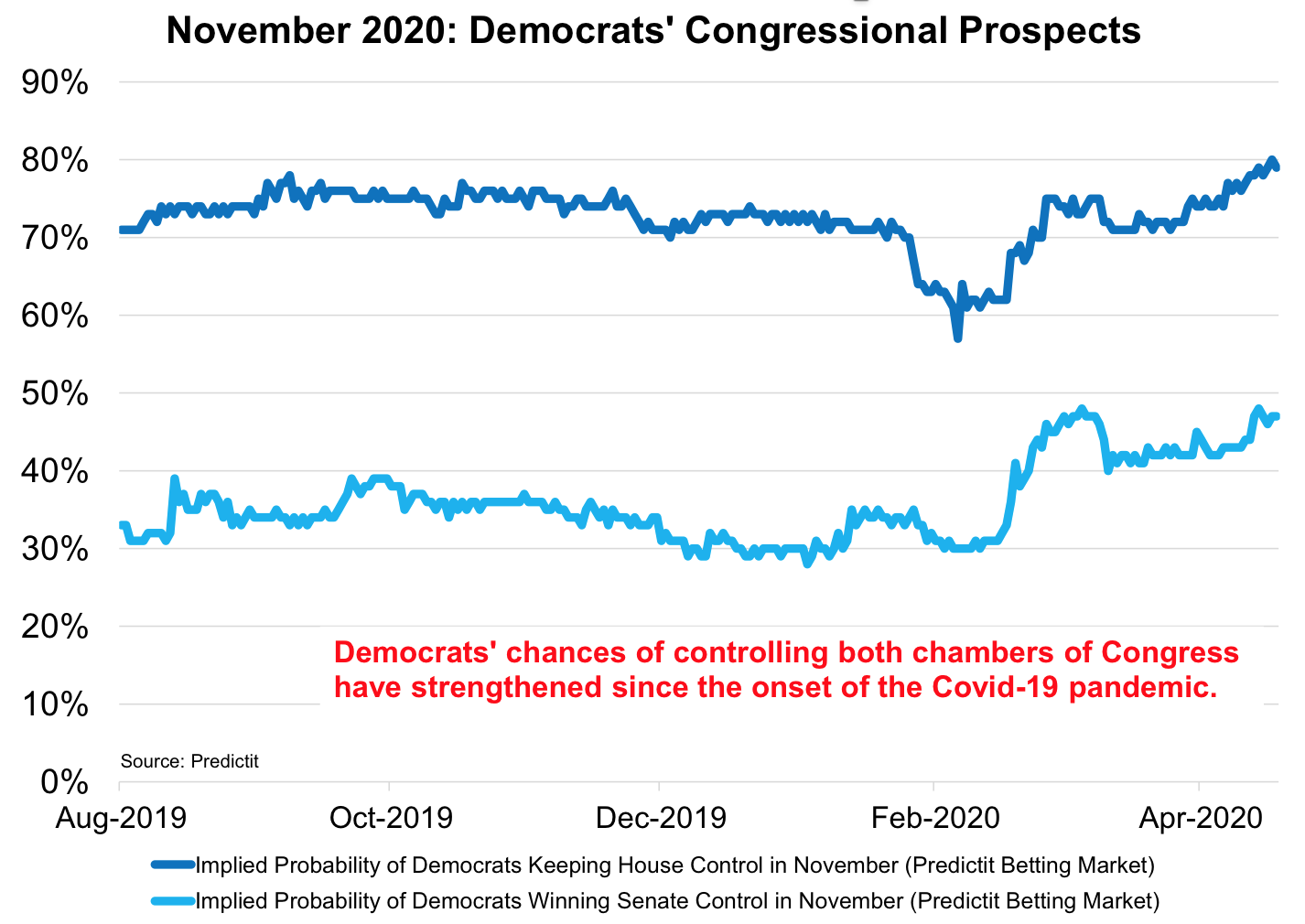Tale of Two Cities: Lufthansa vs United Capital Raises
by Thomas Kirchner, CFA & Paul Hoffmeister
· Lufthansa’s rescue is entirely government-funded, while United Airlines has received government AND private market support.
· Arguably, European markets are underperforming in the recovery due to overregulation.
· European regulators are beginning to recognize the problem.
· MiFID II to be relaxed by … even more regulation.
Lufthansa’s billion Euro government rescue stands in sharp contrast to the free market approach taken by U.S. airlines in raising the capital necessary to bridge the corona-lockdown. It also explains why the recovery of European stock markets lags the U.S. by substantial margins, illustrating what is going wrong in the Eurozone.
Raising Capital
On April 20, United Airlines raised $1 billion in equity in the financial markets. The capital raise occurred at a 5% discount to the already depressed stock price. But despite the bleak state of the industry, with 90% of the fleet grounded, United was able to raise a 10-figure amount in equity. As early as March other airlines had raised billions of dollars of capital in debt, both through asset-backed securitizations and unsecured or convertible debt offerings [ii]. However, United’s April raise was the first attempt to raise equity capital. The dilution suffered by shareholders was about 15%, a relatively modest amount in light of the circumstances. Separately, United had received $6 billion of government loans, with which it issued warrants to the government that diluted shareholders by about 7%. [i]
In contrast, Lufthansa made plans to access capital markets but abandoned them in April. The planned capital increase of $2.6 billion of equity and convertible bonds would have diluted shareholders by approximately 36%, yet still would have been insufficient in the eyes of some analysts to see the company through the epidemic [ii]. The anticipated $9.7 billion rescue package of debt and equity would be entirely government-funded. Dilution appears at first sight less severe than what the original private market raise would have resulted in and will only be 25% if all conversion options are exercised. However, the real strings attached to the financing come from the influence that the government plans to exercise over the company: two board seats will be filled by government representatives. [iii] But the convertibility of the debt into up to 25% of the equity is what the government may be really after, because a 25% holder has, under most European corporate laws, the ability to block strategic transactions. Even though it is unlikely that Lufthansa will be the subject of a hostile takeover, this sets a precedent for more government influence over industry, a potential power grab that has featured prominently in political discussions for some time. As an aside, a similar ownership structure has been in place at Volkswagen for decades, where it seems to do little harm to the company, although it may not do much good anyway because the presence of State representatives did not prevent the emissions fraud scandal.
Europe’s fear of financial markets
The different approach to survival amidst today’s travel slump may be a direct function of the difference in development of financial markets on the two continents.
Europe’s financial markets have been underdeveloped. Capital was provided mostly by banks. In the U.S., however, financial markets have been more vibrant. Regulations in the wake of the financial crisis have only exacerbated the discrepancy.
Under the guise of stabilizing the economy, European regulations have sought to stifle markets. U.S. regulators have created bureaucratic burdens but arguably not enough to kill off markets to the same extent as the EU. Sure, as a result of Dodd-Frank overregulation, liquidity in high yield markets has been challenging for a couple of years -- even before the Covid-19 crisis. The rules born out of the 2008 financial crisis may also be responsible for the repo debacle that has roiled funding markets since last September. And while the current administration would like to relax these tight rules, it may actually be the banks themselves that want to keep them as barriers to entry against foreign competition.
But all these problems are minor compared to the anti-market activism of EU regulators. Now that private enterprise needs capital, there aren’t many markets to turn to in Europe. Government support may be the only option.
MiFID U-Turn
If you think this is an exaggeration consider this: French securities regulator AMF calls for a suspension of MiFID II, an EU-wide regulation enacted two years ago that limits how brokers can run their business. It is known for forcing brokerage firms to bill clients for research services that used to be provided for free, and are still free in U.S. and Asian markets. AMF chief Robert Ophele was recently quoted by Bloomberg as criticizing rules that limit the ability of companies to raise capital and recover from the coronavirus pandemic. “Right now we have debt, but debt could be only part of the story for the recovery. We need capital, and it’s clear in some parts MiFID II could be reviewed in order to enhance or facilitate the possibility of raising of capital... How do we increase capital, equity issuance in our European companies, which will be key for the recovery of our economy?” [iv]. Ophele’s criticism follows a report by AMF in January that decries how MiFID “undermines” the market. [v]
The irony in this lies in France’s reputation as a stalwart of anti-market rhetoric, which is now admitting defeat with what is a de-facto U-turn. Of course, such U-turns are nothing new in France. President Mitterand, France’s first Socialist president after World War II, nationalized major industries after his 1981 election, only to privatize them again starting in 1986 once it had become obvious that State ownership was counterproductive to the hoped-for benefits.
Of course, the idea of overregulation killing the market is not a new one and is what critics of the rules have been warning about since when the rules were first introduced.
Trapped in Underperformance
As we have pointed out in prior commentary, European markets are underperforming U.S. markets in the recovery from the sharp selloff in March. Over the last month the discrepancy has widened dramatically.
With the S&P 500 down about 8.5% year-to-date, Europe overall underperforms by roughly 13.7 percentage points as of last Friday. The problem markets are down even more, with France underperforming by nearly 18.5 and Italy 18.9 percentage points. Spain is dead last, underperforming by a devastating 21.8%. [vi]
It is clear now that short selling bans announced in Italy and France during the selloff in March have not helped these markets perform better. Whether these bans are responsible for the underperformance is another question. As tempting as it is to blame short selling for the underperformance, more research will be needed to answer that question definitively. Most likely, short selling bans are merely one aspect of a confluence of unfortunate policy decisions that also include the aforementioned MiFID II and ultimately high tax regimes that stifle investment.
Investment Conclusions
In our view, it is too early to invest in airlines as distressed investments. The outcomes are too binary to make financial commitments at this time. If the economic reopening is successful, then the airlines may well have sufficient funds to emerge from the crisis. However, if prognosticators of a second wave turn out to be correct, then we would not want to own any airline-related security that was purchased at current price levels. Should that scenario play out, then we would want to invest along the lines of the 2003 airline bankruptcies when the most successful investments were arguably in airplane lease securitizations, where investors were backed with good assets, yet the securities traded at substantial discounts to the value of the assets because the issuing airlines were in bankruptcy.
Thomas Kirchner,CFA, has been responsible for the day-to-day management of the Camelot Event Driven Fund since its 2003 inception. Prior to joining Camelot he was previously was the founder of Pennsylvania Avenue Advisers LLC and the portfolio manager of the Pennsylvania Avenue Event-Driven Fund. He is the author of 'Merger Arbitrage: How To Profit From Global Event Driven Arbitrage.' (Wiley Finance, 2nd ed 2016) and has earned the right to use the CFA designation.
Paul Hoffmeister is chief economist and portfolio manager at Camelot Portfolios, managing partner of Camelot Event-Driven Advisors, and co-portfolio manager of Camelot Event-Driven Fund (tickers: EVDIX, EVDAX).
Mr. Hoffmeister is a graduate of Georgetown University with a BS in Accounting and Finance, and MBA from Northwestern’s Kellogg School of Management.
[i] Author’s calculations and Tracy Rucinski: “United Airlines sells $1 billion of stock in fresh move to weather pandemic.” Reuters, April 21, 2020.
[ii] Eyk Henning, William Wilkes, and Jan-Henrik Foerster:” Lufthansa Seeks Investor Support for Share Sale in Funding Push.” Bloomberg, April 9, 2020.
[iii] David Kaminski-Morrow: “Lufthansa Group nears deal for €9bn financing package.” Flightglobal.com, May 21, 2020.
[iv] Silla Brush, “‘Urgent’ MiFID Revisions Could Revive Europe, AMF Chief Says. “ Bloomberg, May 18, 2020.
[v] Jacqueline Eli-Namer, Thierry Giami: “Reviving Research in the Wake of MiFID II: Observations, issues and recommendations.” Autorite des Marches Financiers, amf-france.org, January 2020.
[vi] Total return of each index year to date through 5/21. Europe: STOXX50. Italy: FTSE MIB. France: CAC 40. Spain: IBEX 35. Source: Bloomberg.
Disclosures:
• Past performance may not be indicative of future results. Therefore, no current or prospective client should assume that the future performance of any specific investment, investment strategy (including the investments and/or investment strategies recommended by the adviser), will be profitable or equal to past performance levels.
• This material is intended to be educational in nature, and not as a recommendation of any particular strategy, approach, product or concept for any particular advisor or client. These materials are not intended as any form of substitute for individualized investment advice. The discussion is general in nature, and therefore not intended to recommend or endorse any asset class, security, or technical aspect of any security for the purpose of allowing a reader to use the approach on their own. Before participating in any investment program or making any investment, clients as well as all other readers are encouraged to consult with their own professional advisers, including investment advisers and tax advisors. Camelot Event Driven Advisors can assist in determining a suitable investment approach for a given individual, which may or may not closely resemble the strategies outlined herein.
• Any charts, graphs, or visual aids presented herein are intended to demonstrate concepts more fully discussed in the text of this brochure, and which cannot be fully explained without the assistance of a professional from Camelot Event Driven Advisors. Readers should not in any way interpret these visual aids as a device with which to ascertain investment decisions or an investment approach. Only your professional adviser should interpret this information.
Originally published on http://www.camelotportfolios.com/commentaries

















